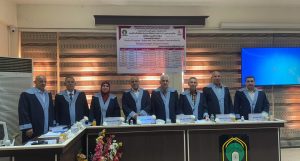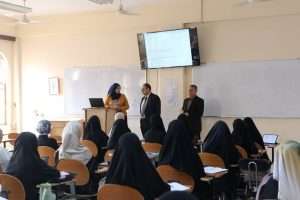The College of Science has organized a seminar on the use of aqueous and non-aqueous sol-gel methods to prepare some mixed oxides that are used as catalysts in ethylene oligomerization reactions, in the presence of the dean of the college, the scientific and administrative assistant, and a number of faculty members.
The seminar aims to the sol-gel method that presented an interesting method for preparing mixed oxides as well as exploring two processes, aqueous solution (HSG) and non-aqueous solution (NHSG) and showing how to prepare SixAly supports and successfully use them as heterogeneous catalysts in the esterification reaction. Using the HSG process, SixAly mixed oxides were prepared by NHSG. SixAly mixed oxides showed well-controlled formulations and porous textures, with high acidity. In this way, the Si/Al ratio can be easily controlled, although it plays an important role in the structure, texture and acidity of the samples. As well as the statement of the strong dependence of the fabric on the ratio of Si / Al and on the synthesis conditions, and the study of the structures by XRD and NMR, which indicates that all the mixed oxides are amorphous, and special interest in studying the effect of the composition (Si / Al ratio and nickel loading) on texture, structure and acidity and surface properties.
The lecturer has concluded that the samples with high Al content performed excellently with a very high specific activity of up to 270 mmol ethylene converted per gram of catalyst per hour at 150°C, and the proportion of biotin in the products increased by about 70%. These catalysts compare well with typical catalysts prepared by time-consuming multistep procedures from expensive mesoporous silica stents.






























































